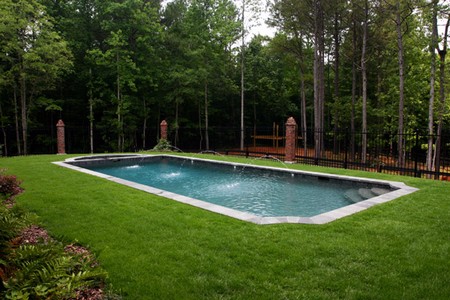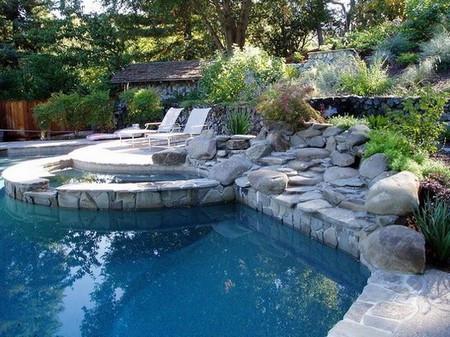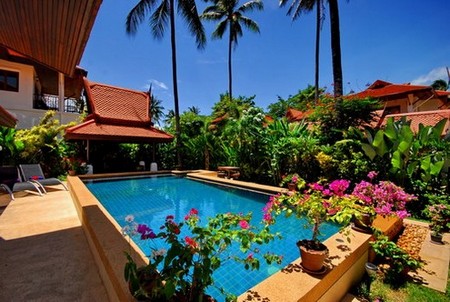Reflection and geometrical precision are the key elements in formal pool garden. The inclusion of two small pools, which mirror each other in shape and size, provides a relatively large surface area of water without dominating the garden, as a larger, single pool would do. Although softened a little by plants, the formal rectangular lines are maintained throughout the plot.
This garden breaks a lot of rules, suggesting that it has a slightly maverick owner. It has been designed as if it were bigger than it really is, but the design works. Usually, for example, small pavers look best in small areas, but here the effect of using the large, cream-coloured paving stones is to make the garden appear larger and lighter.
The plants are uncomplicated, and varieties have been chosen that prefer shady, moist conditions. Shades of red and greens in the foliage echo the hues of the water and the brickwork. With its very strong design, clear lines and rich, varied planting, this garden is one that invites you to explore it.
Features
The large, rectangular, cream-coloured pavers reflect light and emphasize the clean lines and regularity of the design. The main focal points are the two square pools, and little in the garden detracts from them, ensuring that the formal feel is maintained. The pools reflect the sky above and the foliage around them, adding another dimension to the garden, and the pools themselves offer a different medium and extend the range of planting that is possible.
The garden is subtly divided into two halves. The area nearer the house is very light and airy, with the hard lines of the pavers and pool deliberately maintained. In the other half of the garden, further from the house, there is a narrow flowerbed on one side and a wider bed on the other, which has space for a range of plants that cannot be grown in the part of the garden nearer to the house
A single statue at the far end of the pool furthest from the house serves as a focal point, drawing the eye down the garden, and the trickling water from the pot adds sound and another dimension to the garden.
The brick walls, which provide a strong contrast to the pavers, are an effective backdrop to the planting, but the house walls are painted white in order to reflect light back into the garden.
A double row of bricks in front of the far bed introduces a change of surface, and a few pots containing small shrubs in front of the bed give added depth to the plants and make the garden seem larger. The use of a square container in the group between the pools emphasizes the shape of the pools but breaks the continuity by adding some evergreen plants with interesting foliage.
Planting
The planting is as diverse as would normally be associated with a larger garden, and the inclusion of the trees is important in maintaining the illusion of space. The two small trees, Carpinus betulus (hornbeam) and Pyrus salicifolia ‘Pendula’ (weeping pear), not only add height but also serve to cover the bare walls effectively.
The trees are balanced by areas of interest at lower levels in the garden. Using plants of diverse habits and heights provides lots of variety, and the eye is drawn to many places in the garden without the clear geometrical pattern being interrupted.
In the portion of the garden near to the house the walls are largely bare, but they are increasingly clothed with plants until, in the far corners, they are almost totally covered, creating the illusion that the garden goes on further than it does.
The planting around the pools is simple, with a few overhanging plants at the edges so that their strong outlines ate uninterrupted.
Colours are kept gentle, and a large, cream-coloured, earthenware planter holds a variety of pink and purple flowering plants to bring colour closer to the house. Containers are also used to bring plants to areas that would otherwise be bare, thus limiting the need to create flowerbeds and allowing the continuity of the paving to be maintained, and one or two small ornamental trees in containers can be moved to give the best effect at different seasons.
The trellis against the house gives extra room for climbers and increases the surface on which plants can grow without taking any space from the garden itself.
Categories
Advertisements
Recent Articles
 How to Understand Bed Sizes – A Small Guide
How to Understand Bed Sizes – A Small Guide How to Select Some Must Have Kitchen Accessories
How to Select Some Must Have Kitchen Accessories Best Way to Change a Car Tire
Best Way to Change a Car Tire Best Way to Write an Affirmation
Best Way to Write an Affirmation Best Way to Take Charge of Your Financial Life
Best Way to Take Charge of Your Financial Life Best Way to Survive a Party When You Don’t Know Anyone
Best Way to Survive a Party When You Don’t Know Anyone Best Way to Stop Self Sabotaging Yourself
Best Way to Stop Self Sabotaging Yourself Best Way to Start Journal Writing
Best Way to Start Journal Writing Best Way to Speak with a Powerful Voice
Best Way to Speak with a Powerful Voice Best Way to Simplify Your Life
Best Way to Simplify Your Life Best Way to Respond to a Put-Down
Best Way to Respond to a Put-Down Best Way to Reduce Acne Breakouts
Best Way to Reduce Acne Breakouts Best Way to Recover from Dining Disasters
Best Way to Recover from Dining Disasters Best Way to Quit Your Job Gracefully
Best Way to Quit Your Job Gracefully Best Way to Make Your Own Website
Best Way to Make Your Own Website




Leave a Reply